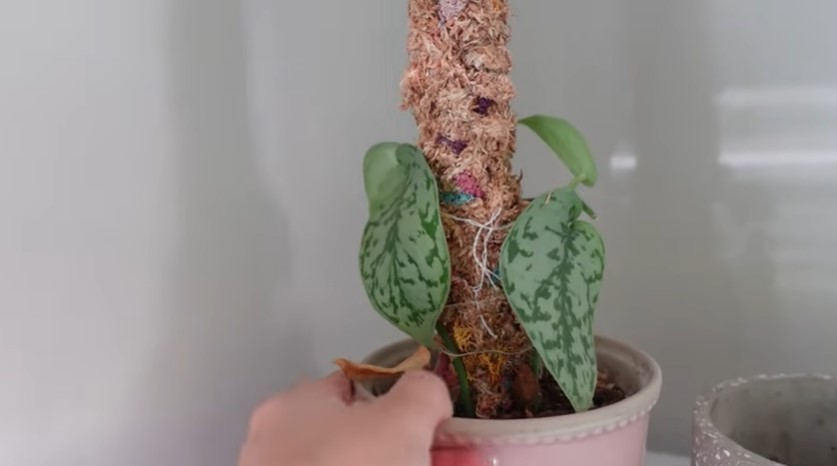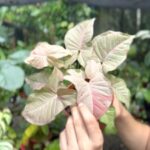Wishing to add a new plant to your home garden? Then you may want to consider growing lovely Scindapsus plants. Scindapsus is popular and loved by many for its bright foliage, making them an excellent addition to your garden. This is the reason why today, we’ll be telling all about different Scindapsus varieties to grow at home.
Scindapsus plant is in the top 10 of most air-purifying plants. The stomata in the leaves remove harmful substances from the air and absorb them. That’s great at home and makes the Scindapsus a great colleague in the office. Place it near the printer or other devices so that the plant can also work there for a healthy atmosphere.
Scindapsus plants are relatively easy, low-maintenance plants to grow at home, but things may seem challenging when you are new to the Scindapsus varieties. However, we’ll start with the basics, how to plant them, and of course, how to care for your plant. Continue reading and learn about different Scindapsus varieties.
Scindapsus Brief History
The official name of this plant is Epipremnum pinnatum, the name of the variety “Aureum.” However, the plant is better known under the old name: Scindapsus aureum, simply “Scindapsus.” The Scindapsus belongs to the Araceae family and is native to the forests of Southeast Asia, where the leaves of the climbing plant can grow up to 100 cm. The European variety is a youthful form of this plant.
They are slender climbers with rather thick leaves. The leaves are green with yellow spots. When there is little leaf green, the plant needs a lot of light. Nevertheless, this tropical plant tolerates dry and rather dark places. In winter, the plant can be placed in a cooler room.
The Scindapsus belongs to the family Aureum. The name means ‘on stem’ in Greek since the plant is also often found as ivy in the wild. The Scindapsus is found in Southeast Asia, Indonesia, and the Solomon Islands.
Scindapsus Varieties FAQ’s
Is Scindapsus the same as pothos?
Pothos has multiple different names, both scientific and common, which can make it challenging to identify by name alone. More recently, it still tends to be known as Scindapsus aureus in much of Europe. In America and Canada, Epipremnum pinnatum. The Botanist of today will call it Epipremnum aureum.
What is Scindapsus blue?
The Blue Satin Scindapsus flaunts shiny, blue/green foliage we’ve never seen before, with that same Scindapsus sharpness we all know and love. It can tolerate medium to low indirect light but prefers moderate to bright indirect light.
What is the difference between silver splash and Exotica?
Scindapsus pictus silver splash leaves have the same aqua green and silver coloring that Exotica has. However, silver splash has a much more delicate silver variegation. Exotica can also have this same pixelated variegation, but from looking at pictures, it seems that the Exotica has much more pronounced variegation.
Is Scindapsus pictus Exotica Rare?
Even though this satin pothos has an exotic and unique silverish foliage, it’s not so rare to find in the market given the high demand it suffers.
Are Scindapsus fast growers?
They’re slow to moderate growers. If you have yours in low light, the growth rate will be even slower. I generally repot my Scindapsus every 3-5 years.
Is a Scindapsus pictus a pothos?
You’ve probably seen this pretty vining plant with glittery, silvery variegation on its leaves. It’s usually sold as a “satin,” “silver,” or “silk” Pothos or Philodendron. pictus would be found climbing up trees or vining along the ground.
How to grow and care for Scindapsus?
Location
The Scindapsus is soon satisfied with its location, provided it is not in direct sunlight. Even in a shady spot, the plant can survive, although it prefers some light. The leaves will change in color when the plant is placed in a lighter or darker spot. In a darker area, the leaves turn green, and in a lighter site, the leaves become lighter and more colorful. If the plant is in a draughty spot, the chance of pests is greater. Prevent this from happening.
Humidity
This plant doesn’t require a lot of humidity; it can thrive in dryish places, so you won’t need to worry about buying humidifiers for this plant.
Temperature
A minimum temperature of 20 degrees Celsius is recommended during the day and a minimum temperature of 15 degrees Celsius at night.
Watering
The soil of the Scindapsus should never be dry and should therefore always be kept slightly moist. The plant is also used to this naturally in the rainforests. Too much water is not good, and therefore make sure that there is no layer of water at the bottom of the pot. A layer of water can cause root rot, and you don’t want that either. You could check if the soil is still moist by putting your finger in the soil.
Nutrition
It is only necessary to give some extra plant nutrition in the summer. But if this is not done, it is also fine, but it makes the plant even stronger and more beautiful, so it is recommended. Feed twice a month in the summer. In winter and autumn, the plant is in a resting position, so the plant uses little energy, and extra nutrition is unnecessary. The nutrients of the food will be in the soil, making the soil acidic, which the roots will not like. So don’t feed in winter and autumn.
Spraying
It is only important to spray the plant from time to time to ensure that pests are kept away. It will also remove all dust and increase the ornamental value.
Repotting
It is important to repot the plant every 2 to 3 years. The new pot should be a few centimeters larger than the growing pot, and add some extra soil if necessary. Always pot in the spring, as the plant can still recover from any damage.
What diseases affect the Scindapsus plant?
The Scindapsus is a strong plant and, therefore, not very susceptible to diseases. If the plant does suffer from pests, it is recommended to control this as soon as possible with a biological or, if desired, a chemical pesticide.
Planting Tips:
- Fill the new container about a quarter full of a rich, well-drained potting mix. Water to settle the soil.
- Gently remove your plant from its present container, checking the root system for bunching and carefully pulling it apart, if needed.
- Place the Satin Pothos in its new container. If you are using a moss stick for it to climb upon, now is the time to insert it into the pot.
- Fill the remainder of the pot with potting mix, pressing it firmly around the moss stick, if needed, and firming it around the plant’s base.
- Water the soil again until it runs from the bottom drain holes. Place your plant in an appropriate location indoors with bright indirect light.
Scindapsus Varieties
Most common Scindapsus Varieties
- Scindapsus pictus Argyraeus (commonly called Satin Pothos): Argyraeus is the most common variety. The name means silvery, used to describe the variegation on the leaves.
- Scindapsus pictus Exotica: This is another common variety, known for its larger leaves and more intense variegation and the variegated edging around each leaf.
- Scindapsus pictus Silver Satin: Silver Satin leaf’s shape is very similar to Exotica, but the amount of variegation on each leaf is less. Exotica’s leaves are more splash than not down the center with a variegated edging; Silver Satin has more erratic splashes and speckles across each leaf with no variegated edging.
- Scindapsus pictus Silvery Ann (commonly called Silvery Ann Pothos or Silver Pothos): Silvery Ann has the leaf size and form that is similar to Argyraeus, but the leaves have much more variegation. The leaves are commonly at least half covered in silvery sheen with speckling or splashes on the remaining portion.
Rare Scindapsus Varieties
- Scindapsus treubii: Scindapsus treubii is currently available in 2 varieties, ‘Moonlight’ and ‘Dark Form.’ The leaf-shape of S. treubii is narrower than the S. pictus varieties but still maintains an asymmetrical hook at the end.
- Scindapsus hederaceus: Scindapsus hederaceus is described as being quite similar in appearance to Scindapsus officinalis; which isn’t commonly kept as a houseplant but is used in medicine. S. hederaceus has shiny, green leaves and is native to Thailand, Indo-China, and Malesia. It has been found in forests climbing trees and rocks.
- Scindapsus pictus Jade Satin: This plant has dark, thick green leaves with a bit of a sheen. It is rarely available but is a prolific grower, just like the other varieties of Scindapsus pictus.
Scindapsus Varieties
Scindapsus Pictus Argyraeus
Satin Pothos is just as easy to grow as its relative, golden pothos (Epipremnum aureum). Keep it warm and take care not to overwater this house plant. Cold drafts and soggy soil are two things it won’t tolerate.
Grow pothos indoors, preferably with bright, not direct light, although it also will tolerate low-light conditions. Pale leaves mean too much sun, and loss of variegation means too little.
Pothos likes to have its soil dry out between waterings. It dislikes soggy roots. Grow in any well-draining potting soil. Pothos is a light feeder, but you can give it a monthly snack with a balanced fertilizer formulated for houseplants.
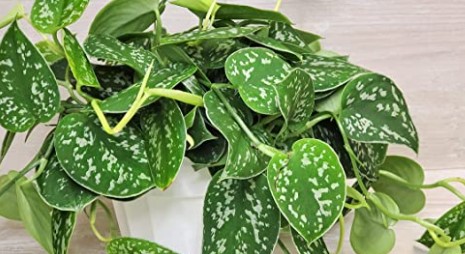
Features:
- Light feeder
- Well-draining potting soil
Exotica Silver Satin Pothos
Scindapsus Pictus’ Exotica’ is a rare trailing and vining plant famous for plant collectors. It has a striking light green foliage with silvery, spotty leaves but a green streak in the middle of the leaves.
The heart-shaped leaves are velvety to the touch and matte in texture. Water every 7-10 days when the top 2″ of soil is dry. When the leaves curl a little, it’s a good time to water. Do not let the plant dry out.
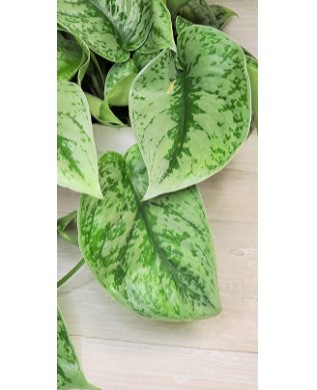
Features:
- Indirect sunlight
- Potting Soil
Pothos Plant Live Silver Satin
These indoor plants live in various lighting conditions with very little attention needed. Sometimes called devil’s ivy, your pothos plant will vine out in a vibrant display of green and keep you delighted with frequent new growth.
We offer various popular pothos plants, such as golden pothos, neon pothos, and marble queen pothos. Choose your favorite or create a diverse ecosystem in your own home with one of each. Additional plastic hangers included.
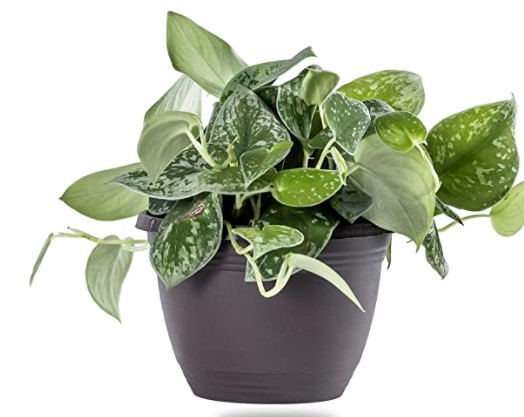
Features:
- Silver Satin
- Indoor
Golden Devil’s Ivy – Pothos – Epipremnum
Golden pothos is a popular house plant known for its long, trailing stems that can grow to 8 ft (2.4 m) or more. A tree-climber in its native tropical habitat, this plant has aerial roots that can be trained to climb a moss stick or trellis.
Its glossy, heart-shaped leaves emerge green and variegated with yellow or white. Although this plant tolerates low light well, its leaves may lose their variegation. It will look its best in moderate or bright light.
One of the easiest indoor plants to grow. Its trailing stems carry heart-shaped leaves that are irregularly splashed with gold. The trailing stems can be trained to grow a trellis or be planted in a hanging basket.
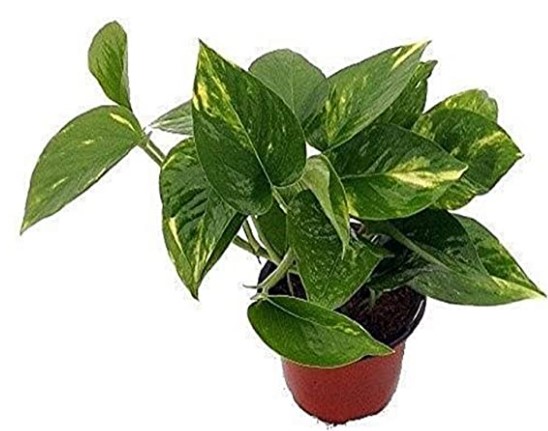
Features:
- GMO-Free
- Scindapus Aureum
- Indirect light
Beautiful plants; check out all the different Syngonium Varieties.

